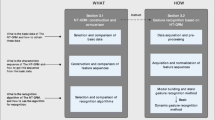Abstract
Gesture recognition based on body-worn devices can be used for healthy improvement and life support. Many methods have been proposed for gesture recognition. However, most of them are concerned about recognition accuracy only. In some practical applications, real-time performance of a recognition method on a wearable device is also a key problem. In the paper, we propose a probability model for accurate and real-time recognition of dynamic gestures. The model learns from HMM but difference in the sense that our model builds probability matrices of feature distribution for each observation points instead of each gesture, which reduces the number of probability matrix to improve processing efficiency. A gesture can be recognized by the way of look-up table to search maximum similarity to pre-stored gestures in the matrices. To verify the model, eight kinds of one-stroke finger gestures are taken as the target of recognition. Result shows reasonable recognition accuracy and computational complexity.
Access this chapter
Tax calculation will be finalised at checkout
Purchases are for personal use only
Preview
Unable to display preview. Download preview PDF.
Similar content being viewed by others
References
Ward, J.A., Lukowicz, P., Troster, G., Starner, T.E.: Activity Recognition of Assembly Tasks Using Body-worn Microphones and Accelerometers. IEEE Trans. on Pattern Analysis and Machine Intelligence 28(10), 1553–1567 (2006)
Zhou, Y., Cheng, Z., Hasegawa, T., Jing, L., et al.: Detection of Daily Activities and Analysis of Abnormal Behaviors Based on a Finger-worn Device. In: Proc. of 5th IET International Conference on Ubi-Media Computing (U-Media 2012), Xining, China (August 2012)
Preece, S.J., Goulermas, J.Y., Kenney, L.P.J., et al.: Activity identification using body-mounted sensors–a review of classification techniques. Physiological Measurement 30(4), R1–R33 (2009)
Bourke, A.K., Lyons, G.M.: A Threshold-based Fall-Detection Algorithm Using A Bi-axial Gyroscope Sensor. Medical Engineering & Physics 30(1), 84–90 (2008)
Dy, J.G., Brodley, C.E.: Feature Subset Selection and Order Identification for Unsupervised Learning. Journal of Machine Learning Research 5, 845–889 (2004)
Rabiner, L.R.: A Tutorial on Hidden Markov Models and Selected Applications in Speech Recognition. Proceedings of the IEEE 77(2) (1989)
Lee, H., Kim, J.H.: An HMM-Based Threshold Model Approach for Gesture Recognition. IEEE Trans. on Pattern Analysis and Machine Intelligence 21(10), 961–973 (1999)
Jing, L., Zhou, Y., Cheng, Z., Wang, J.: A Recognition Method for One-stroke Finger Gestures Using a MEMS 3D Accelerometer. IEICE Transaction on Information E94-D(5), 1062–1072 (2011)
Jing, L., Zhou, Y., Cheng, Z., Huang, T.: Magic Ring: A Finger-worn Device for Multiple Appliances Control using Static Finger Gestures. Sensors 12(5), 5775–5790 (2012)
Author information
Authors and Affiliations
Editor information
Editors and Affiliations
Rights and permissions
Copyright information
© 2012 Springer-Verlag Berlin Heidelberg
About this paper
Cite this paper
Zhou, Y., Cheng, Z., Jing, L., Wang, J. (2012). A Probability Model for Recognition of Dynamic Gesture Based on a Finger-Worn Device. In: Huang, R., Ghorbani, A.A., Pasi, G., Yamaguchi, T., Yen, N.Y., Jin, B. (eds) Active Media Technology. AMT 2012. Lecture Notes in Computer Science, vol 7669. Springer, Berlin, Heidelberg. https://doi.org/10.1007/978-3-642-35236-2_56
Download citation
DOI: https://doi.org/10.1007/978-3-642-35236-2_56
Publisher Name: Springer, Berlin, Heidelberg
Print ISBN: 978-3-642-35235-5
Online ISBN: 978-3-642-35236-2
eBook Packages: Computer ScienceComputer Science (R0)




